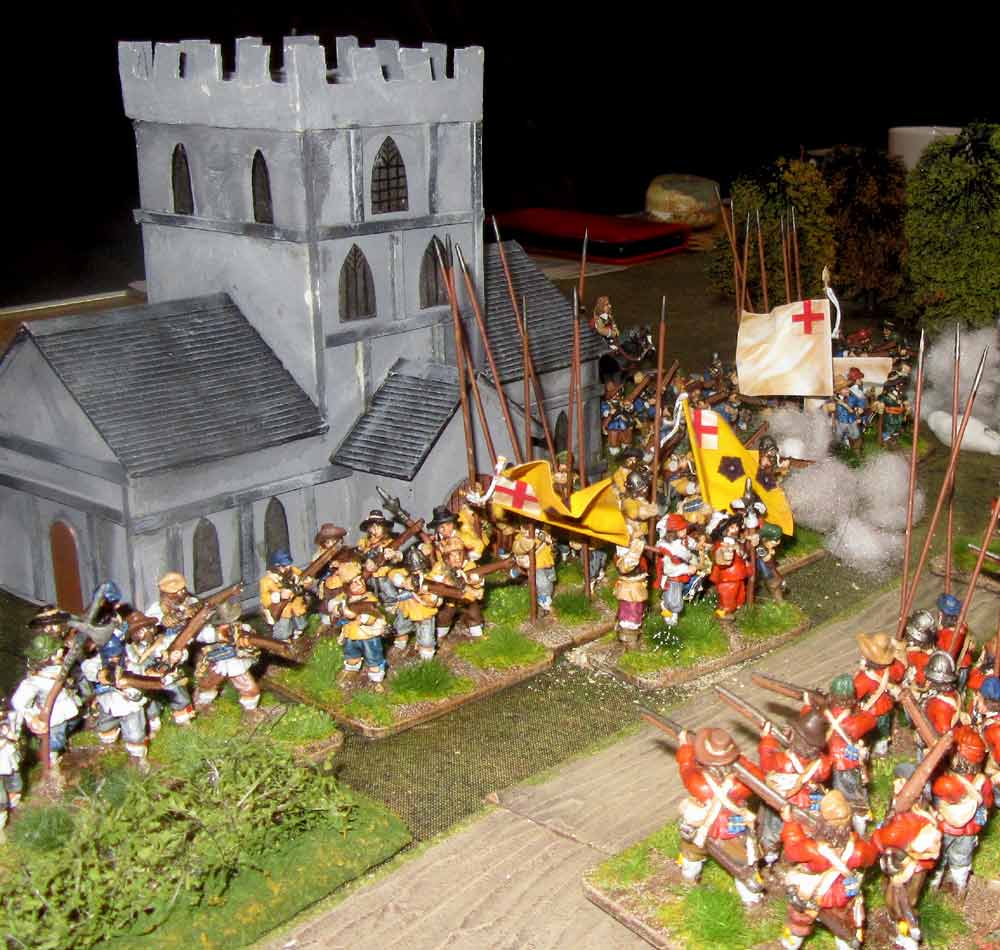
The Battle of Thornton Church, 1644
11th January 2024, 0 Comments
The English Civil War, For King & Parliament, 28mm
By popular demand we returned to the English Civil War this week. For once though, we didn’t game our continued feud between the fictitious earls of Rotherham and Doncaster. Instead, because Sean 2 wanted his pet Sealed Knot reenactment regiment on the table, we based them on real forces – the armies of Parliament’s Eastern Association and the Marquis of Newcastle’s Royalist army. The game was a small one, fought out on a 6×4 foot table. 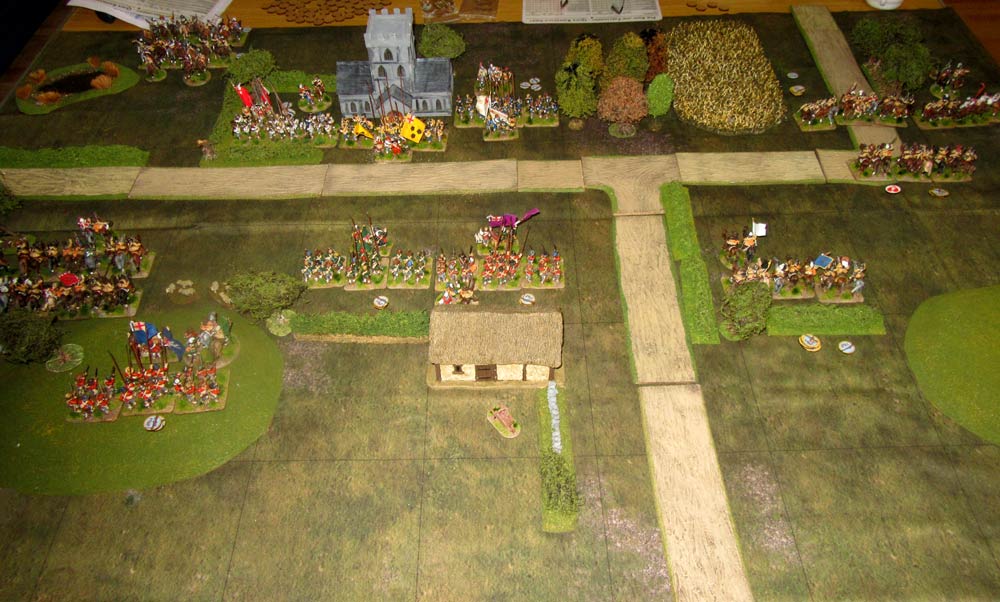 The Royalists – a small force of three regiments of foot and four of horse – were divided between the two Seans. Sea 2 though, made sure his pet “veteran” regiment, Sir George Lisle’s foot – was part of his command. Ally and I commanded the force of Parliament – an equally matched and pretty much identical force, with my “veteran” regiment being The Earl of Manchester’s foot. Everyone else on the table was rated as “seasoned”.
The Royalists – a small force of three regiments of foot and four of horse – were divided between the two Seans. Sea 2 though, made sure his pet “veteran” regiment, Sir George Lisle’s foot – was part of his command. Ally and I commanded the force of Parliament – an equally matched and pretty much identical force, with my “veteran” regiment being The Earl of Manchester’s foot. Everyone else on the table was rated as “seasoned”. 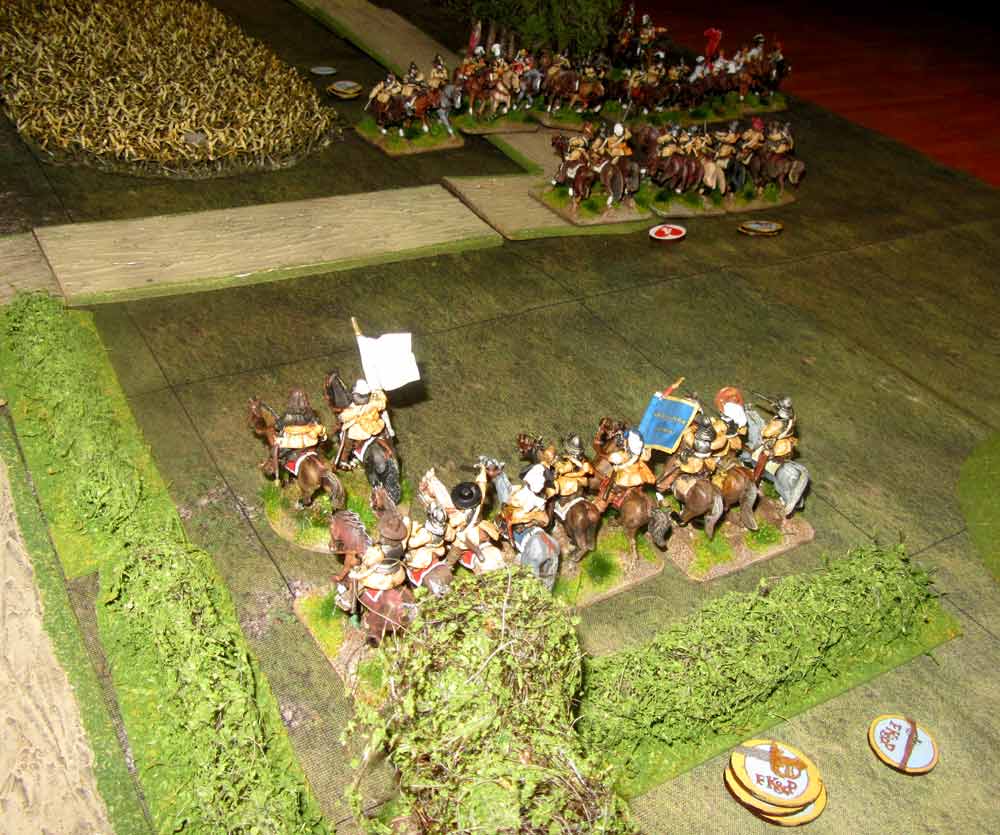 We began by advancing, but the Royalists got the drop on us, and occupied the church and the enclosures around it. this gave them an edge in combat, and would be a tough nut to crack. First though, we needed to do something about the Royalist horse. So, on our right, Ally duly charged them, and in the fierce melee that followed Fleetwood’s Eastern Association horse saw off their counterparts – So far so good then.
We began by advancing, but the Royalists got the drop on us, and occupied the church and the enclosures around it. this gave them an edge in combat, and would be a tough nut to crack. First though, we needed to do something about the Royalist horse. So, on our right, Ally duly charged them, and in the fierce melee that followed Fleetwood’s Eastern Association horse saw off their counterparts – So far so good then.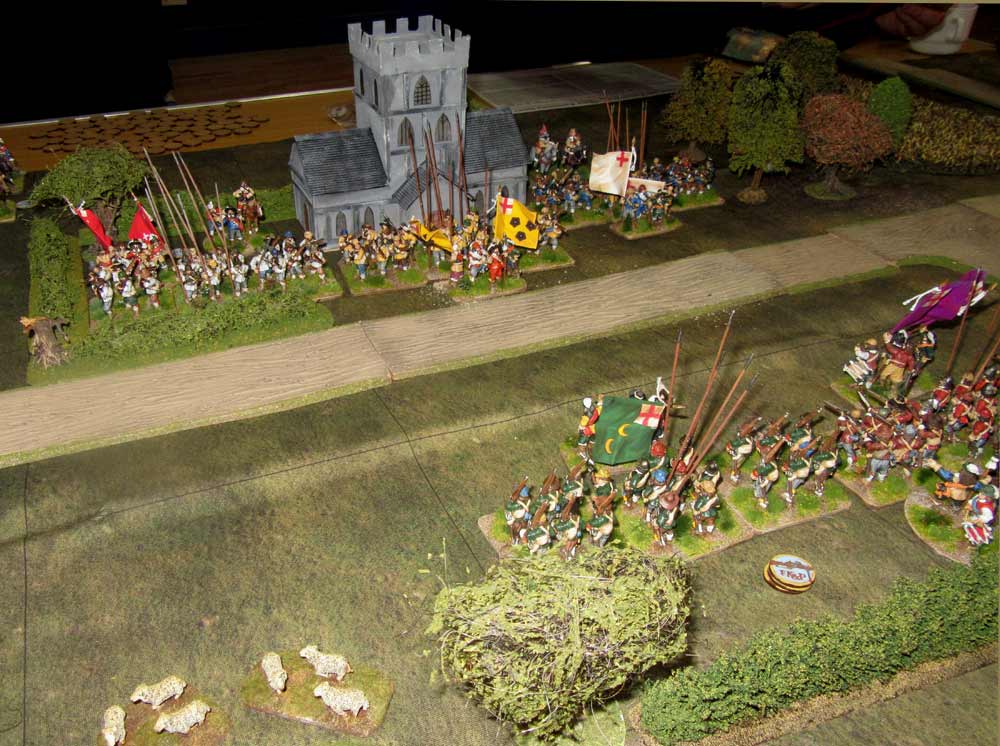 In the fight around the church though, things weren’t going so well. Pickering’s and Montague’s (both in red or russet) took on Lisles’ blue coats, on the left of the Royalist line, leaving the green-coated Manchester’s to occupy the other two Royalist regiments – the yellow-coated Byron’s foot and white-coated Langdale’s on their right. At first it went well, and our shooting was good, but for some reason we couldn’t gain a telling hit on Lisle’s regiment.
In the fight around the church though, things weren’t going so well. Pickering’s and Montague’s (both in red or russet) took on Lisles’ blue coats, on the left of the Royalist line, leaving the green-coated Manchester’s to occupy the other two Royalist regiments – the yellow-coated Byron’s foot and white-coated Langdale’s on their right. At first it went well, and our shooting was good, but for some reason we couldn’t gain a telling hit on Lisle’s regiment. 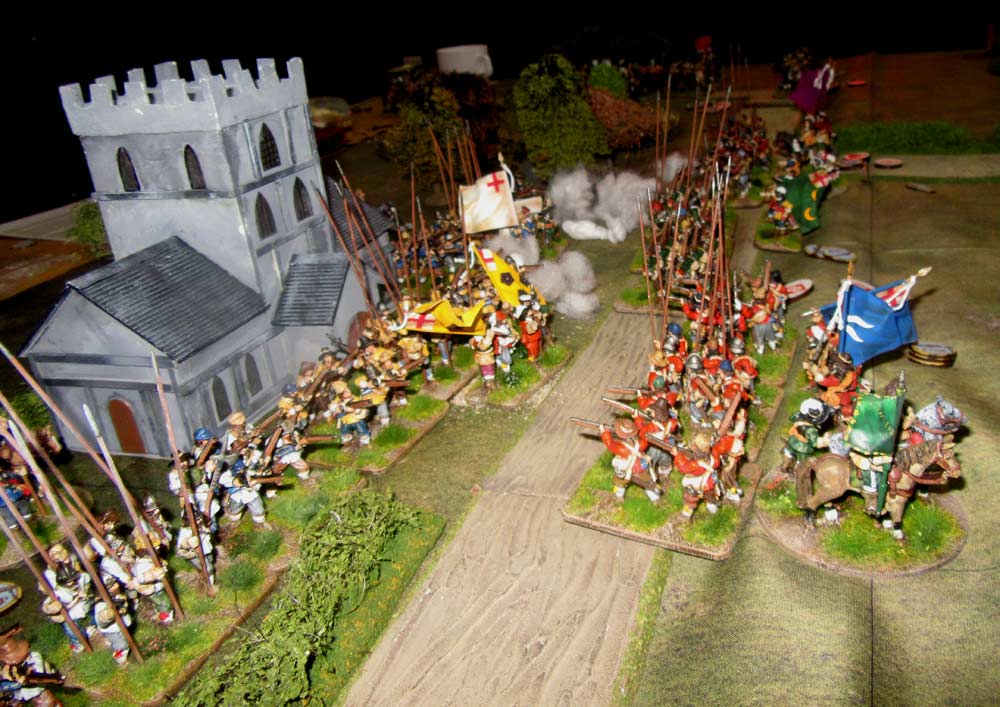 By the way, for rules we use the excellent For King & Parliament set, by Andrew Brentnall and Simon Miller, based on Simon’s equally good Ancient rules, To the Strongest. It uses playing cards for working out activation, shooting and melee, rather than die rolls. Now, rather than cluttering up the table with playing cards, as we’d done before, we used pre-coloured MDF playing card chits from Warbases, which really looked much better, and were easy to use.
By the way, for rules we use the excellent For King & Parliament set, by Andrew Brentnall and Simon Miller, based on Simon’s equally good Ancient rules, To the Strongest. It uses playing cards for working out activation, shooting and melee, rather than die rolls. Now, rather than cluttering up the table with playing cards, as we’d done before, we used pre-coloured MDF playing card chits from Warbases, which really looked much better, and were easy to use. 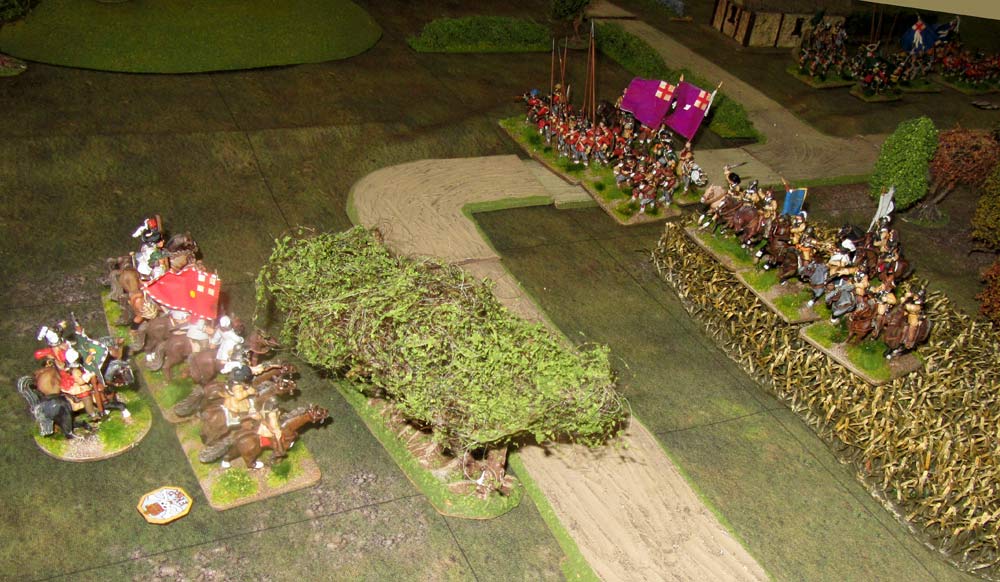 On out left flank my cavalry, led by Cromwell were holding back, waiting to see how things went, but on our right Ally’s alter ego Col. Charles Fleetwood was going for broke. that though, was when it all came unstuck for him. First, despite outnumbering the enemy horse two to one, Manchester’s horse failed to charge into the flank of Lucas’ horse, who promptly turned, charged and drove Manchester’s horse,en from the field.
On out left flank my cavalry, led by Cromwell were holding back, waiting to see how things went, but on our right Ally’s alter ego Col. Charles Fleetwood was going for broke. that though, was when it all came unstuck for him. First, despite outnumbering the enemy horse two to one, Manchester’s horse failed to charge into the flank of Lucas’ horse, who promptly turned, charged and drove Manchester’s horse,en from the field. 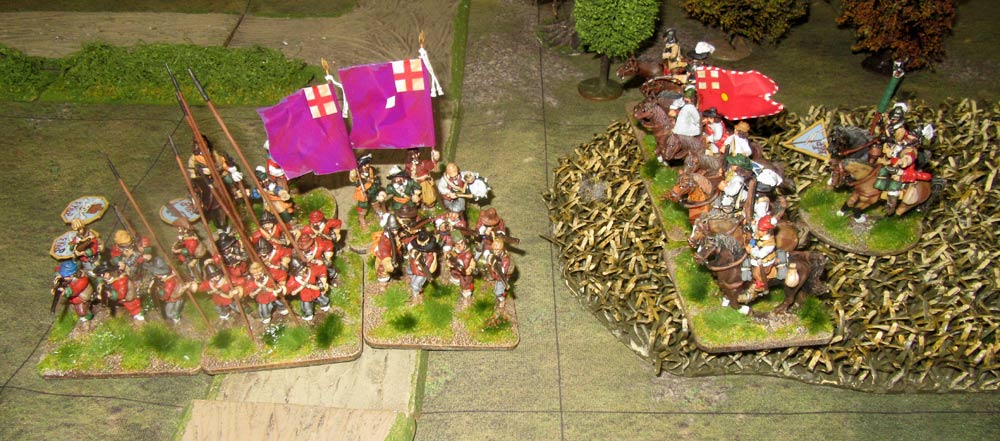 Ally tried to stop the rout by sending Col. Montague’s foot to shore up his remaining cavalry – Fleetwood’s – but it was all too late. the Parliamentarian horsemen were driven from the field, and a victorious Lucas’ regiment pursued – straight into the flank of Montagu’s foot. This time though, Ally pulled out excellent chits, and not only held his ground but drove the Royalist horse back in disorder. That saved the right flank, but what about everywhere else?
Ally tried to stop the rout by sending Col. Montague’s foot to shore up his remaining cavalry – Fleetwood’s – but it was all too late. the Parliamentarian horsemen were driven from the field, and a victorious Lucas’ regiment pursued – straight into the flank of Montagu’s foot. This time though, Ally pulled out excellent chits, and not only held his ground but drove the Royalist horse back in disorder. That saved the right flank, but what about everywhere else? 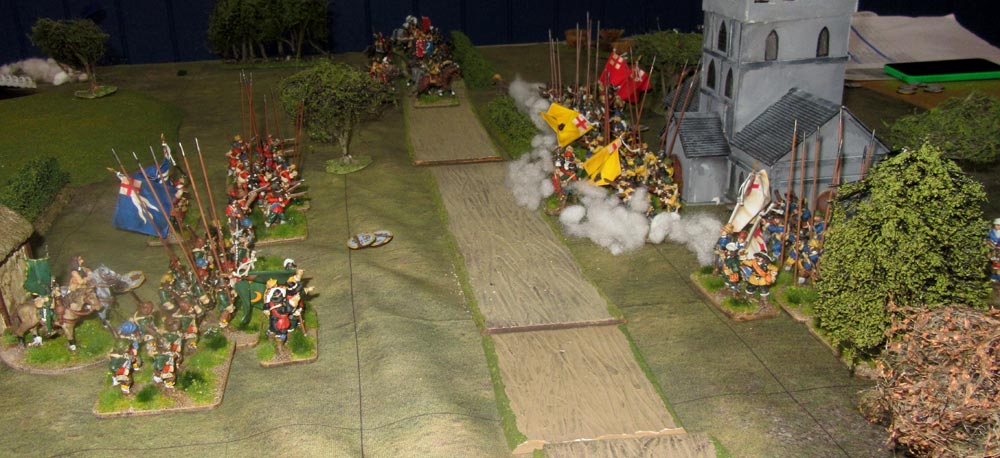 In the centre the two remaining Parliamentarian regiments were disordered, and pull back to rally. Their Royalist opponents were in too nice a position to come out of though, and they held their ground, which led to a lull in the fighting. It was just as well though – just about everyone was out of musket shot. So, essentially, in the fight around the church, Parliament had been repulsed. So, as it was getting close to packing up time, I finally unleashed my cavalry.
In the centre the two remaining Parliamentarian regiments were disordered, and pull back to rally. Their Royalist opponents were in too nice a position to come out of though, and they held their ground, which led to a lull in the fighting. It was just as well though – just about everyone was out of musket shot. So, essentially, in the fight around the church, Parliament had been repulsed. So, as it was getting close to packing up time, I finally unleashed my cavalry. 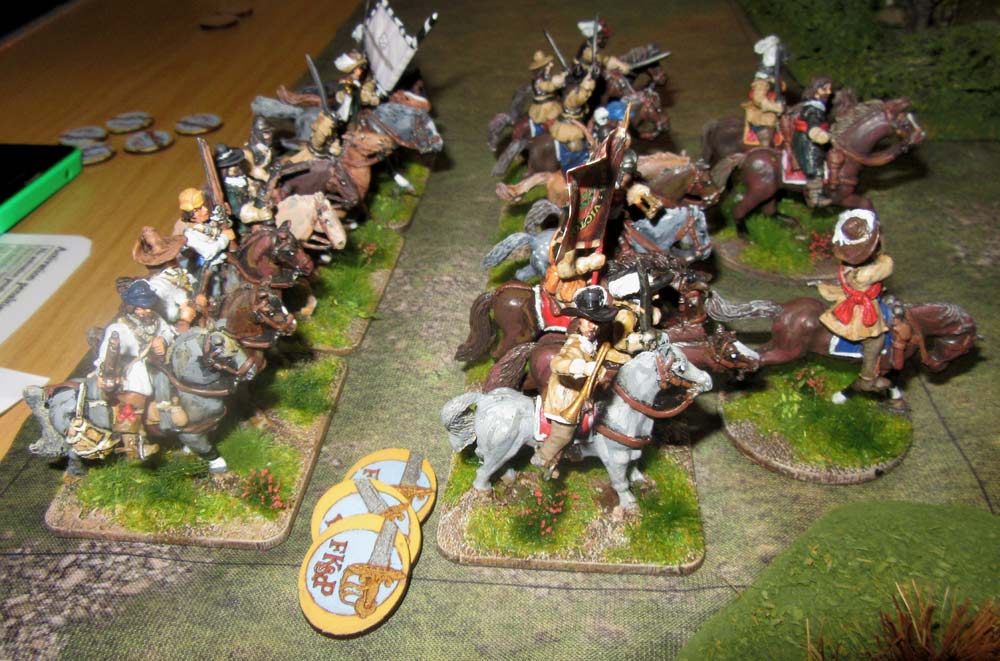 Cromwell’s and Vermuyden’s ironsides vaulted over a hedge, and charged the Royalist horse to their front – Howard’s and Carnaby’s (pictured above) Howard’s were in marshy ground, but that didn’t stop Vermuyden’s, who charged into them, and drove them from the field. Thew trouble was, Vermuyden’s then pursued their remnants off the field, and so took no further part in the game! So, it was up to Oliver Cromwell MP, General of Horse, to save the day.
Cromwell’s and Vermuyden’s ironsides vaulted over a hedge, and charged the Royalist horse to their front – Howard’s and Carnaby’s (pictured above) Howard’s were in marshy ground, but that didn’t stop Vermuyden’s, who charged into them, and drove them from the field. Thew trouble was, Vermuyden’s then pursued their remnants off the field, and so took no further part in the game! So, it was up to Oliver Cromwell MP, General of Horse, to save the day. 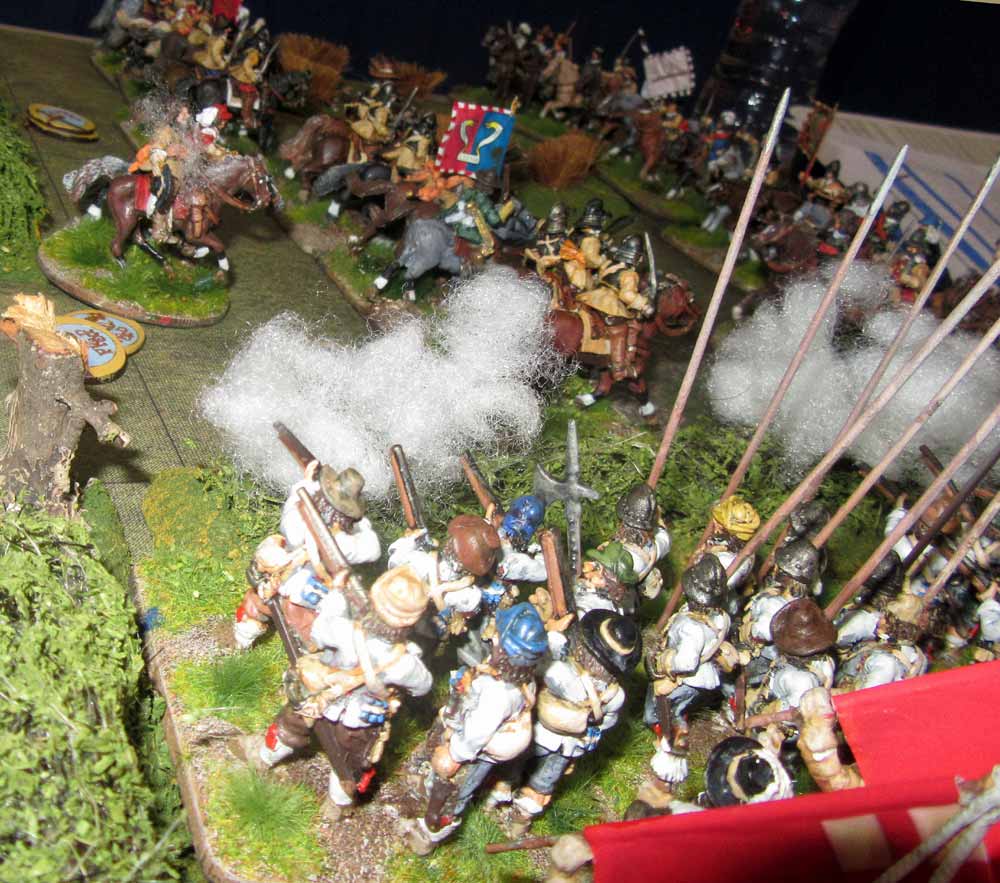 Well, in fact he didn’t. Sir MArmaduke Langdale’s Royalist regiment turned to their flank and fired into Cromwell’s flank. This inflicted a hit, and Cromwell pulled them back out of range. At the time he had Sir Francis Carnaby’s horse on the roped – pinned to the table edge with a hit marked on them. Still, thanks to Sean 1’s quick thinking with Langdale’s, it wasn’t to be. By then though, it was clear that the action was petering out for the day.
Well, in fact he didn’t. Sir MArmaduke Langdale’s Royalist regiment turned to their flank and fired into Cromwell’s flank. This inflicted a hit, and Cromwell pulled them back out of range. At the time he had Sir Francis Carnaby’s horse on the roped – pinned to the table edge with a hit marked on them. Still, thanks to Sean 1’s quick thinking with Langdale’s, it wasn’t to be. By then though, it was clear that the action was petering out for the day.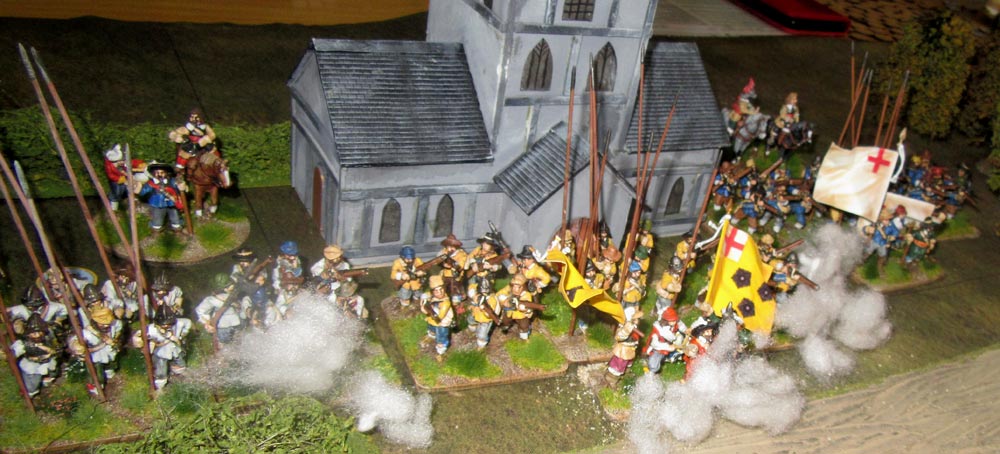 The Royalists still held their line around Thornton church, and there was no budging them. My own two foot regiments (Manchester’s and Pickering’s – had been badly disordered, and had pulled back to lick their wounds, while Montagu’s were off to the right, dealing with those pesky Royalist cavalry. So, we called it a day – a marginal Royalist victory. The unit of the battle award surely went – to Sean 2’s pleasure – to George Lisle’s “stonewall” bloody foot!
The Royalists still held their line around Thornton church, and there was no budging them. My own two foot regiments (Manchester’s and Pickering’s – had been badly disordered, and had pulled back to lick their wounds, while Montagu’s were off to the right, dealing with those pesky Royalist cavalry. So, we called it a day – a marginal Royalist victory. The unit of the battle award surely went – to Sean 2’s pleasure – to George Lisle’s “stonewall” bloody foot! 